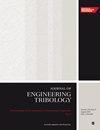真空环境下挤压膜悬浮非接触式悬浮机构的研制
IF 1.8
3区 工程技术
Q3 ENGINEERING, MECHANICAL
Proceedings of the Institution of Mechanical Engineers, Part J: Journal of Engineering Tribology
Pub Date : 2023-11-07
DOI:10.1177/13506501231211624
引用次数: 0
摘要
本文介绍并讨论了在真空和大气条件下用挤压膜机制产生的轻物体悬浮的实验研究结果。采用两种工作物质,即真空泵油和离子液体。结果表明,与离子液体相比,真空泵油能产生更高的悬浮高度。此外,还确定了在真空和大气条件下都可以实现悬浮。在真空条件下,轻物体的悬浮高度略高。本文章由计算机程序翻译,如有差异,请以英文原文为准。
Development of non-contact floating mechanism utilizing squeeze film levitation under vacuum environment
Results of an experimental study on the levitation of a light object created by the squeeze-film mechanism under both vacuum and atmospheric conditions are presented and discussed. Two working substances were used, that is vacuum pump oil and ionic liquid. It was determined that vacuum pump oil produced a much higher levitation altitude of the floating light object compared to the ionic liquid. Also, it was established that levitation can be achieved under both vacuum and atmospheric conditions. The levitation height of the light object was slightly higher under vacuum conditions.
求助全文
通过发布文献求助,成功后即可免费获取论文全文。
去求助
来源期刊

CiteScore
4.20
自引率
5.00%
发文量
110
审稿时长
6.1 months
期刊介绍:
The Journal of Engineering Tribology publishes high-quality, peer-reviewed papers from academia and industry worldwide on the engineering science associated with tribology and its applications.
"I am proud to say that I have been part of the tribology research community for almost 20 years. That community has always seemed to me to be highly active, progressive, and closely knit. The conferences are well attended and are characterised by a warmth and friendliness that transcends national boundaries. I see Part J as being an important part of that community, giving us an outlet to publish and promote our scholarly activities. I very much look forward to my term of office as editor of your Journal. I hope you will continue to submit papers, help out with reviewing, and most importantly to read and talk about the work you will find there." Professor Rob Dwyer-Joyce, Sheffield University, UK
This journal is a member of the Committee on Publication Ethics (COPE).
 求助内容:
求助内容: 应助结果提醒方式:
应助结果提醒方式:


